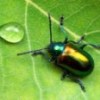
It has long been known that ants recognize their deceased nestmates using the smell of fatty acids that accumulate as the body decomposes. The chemical signature of deadness helps ants remove the corpses from their midst, keeping a clean and sanitary nest. Indeed, this classic tale of ants and oleic acid is one of E. O. Wilson's favorite stories.
But it turns out that the story is even richer than previously supposed. A study by Dong-Hwan Choe et al published in yesterday's PNAS note that Argentine ants (Linepithema humile) carry away the dead even before the fatty acids appear. It seems that the ants not only recognize the scent of death, they also pick the scent of life. (Apparently, life smells of "dolichodial" and "iridomyrmecin".) Here's the abstract:
Abstract: One of the most conspicuous and stereotyped activities of social insects such as ants and honey bees is necrophoresis, the removal of dead colony members from the nest. Previous researchers suggested that decomposition products such as fatty acids trigger necrophoric behavior by ant workers. However, fatty acids elicit both foraging and necrophoric responses, depending on the current nest activities (e.g., feeding or nest maintenance). Furthermore, workers often carry even freshly killed workers (dead for <1 h) to refuse piles before significant decomposition has a chance to occur. Here, we show that the cuticular chemistry of Argentine ant workers, Linepithema humile, undergoes rapid changes after death. When the workers are alive or freshly killed, relatively large amounts of 2 characteristic ant-produced compounds, dolichodial and iridomyrmecin, are present on the ants' cuticle. However, these compounds disappear from the cuticle within about 1 h after death. We demonstrate how this phenomenon supports an alternative mechanism of ant necrophoresis in which the precise recognition and rapid removal of dead nestmates are elicited by the disappearance of these chemical signals associated with life.
Source: Dong-Hwan Choe, Jocelyn G. Millar, and Michael K. Rust. 2009. Chemical signals associated with life inhibit necrophoresis in Argentine ants. PNAS 2009 : 0901270106v1-pnas.0901270106.

Wow, that is awesome. Love that photo.